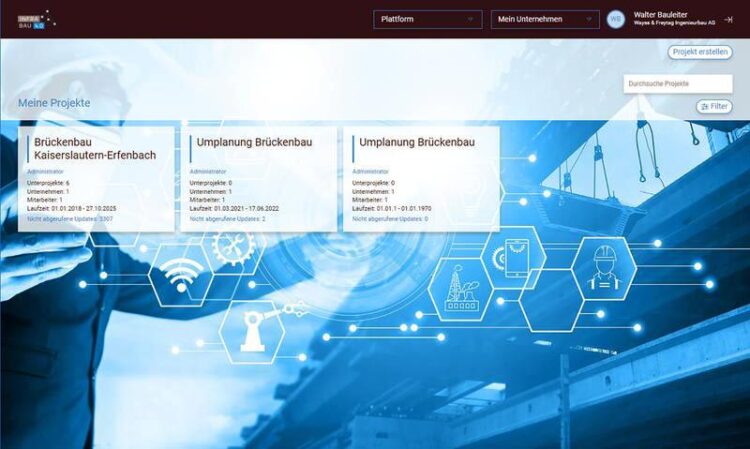Improving efficiency in construction with Infra-Bau 4.0

The project overview window on the Infra-Bau 4.0 platform.
© Fraunhofer IESE
Large-scale construction projects usually involve extensive coordination. In practice, however, the way in which information is exchanged between construction stakeholders often ends up being an inconsistent multistep process. Now, a consortium project under the technical and scientific leadership of the Fraunhofer Institute for Experimental Software Engineering IESE is working on a digital solution in the form of the Infra-Bau 4.0 platform, which establishes a network that takes in every stakeholder in an infrastructure project. It provides a means of mapping out resources and processes digitally, making it easier to plan and reschedule activities during the construction process.
There is a lot of construction going on in Germany – but the construction industry is far from fully exploiting the opportunities offered by digitalization. New working methods such as building information modeling (BIM) can provide digital planning data, but have yet to be implemented on a wider scale – and they are not so well-equipped to deal with scenarios involving networking and rescheduling at short notice, both of which are commonplace on construction sites. This means that construction projects still initiate many of their steps individually, using manual methods, and are lacking automated, coordinated and transparent procedures as well as consistent communication and planning standards.
The Infra-Bau 4.0 project aims to close this gap. With the help of funding from the German Federal Ministry for Digital and Transport (BMDV), a large number of consortium partners from science and the construction industry is developing a digital communication platform that will make it possible to design more efficient infrastructure projects and reduce the workload, time and costs involved as a result. Fraunhofer IESE in Kaiserslautern is providing technical and scientific leadership and bringing its years of expertise in digital ecosystems to the project. “When we talk about digital ecosystems, we mean socio-technical networks where companies, technology and people cooperate with one another using a digital platform, and where each stakeholder benefits from participating,” explains Denis Feth, Expert “Security and Privacy Technologies” at Fraunhofer IESE and project manager on the technical and scientific side. “As part of the project, our institute examined the subject from a holistic perspective, something which involved asking ourselves how a construction industry platform should be structured, how we could encourage participation and how we could ensure that data would be exchanged securely.”
Meta-platform pulling the strings
All these considerations have given rise to the Infra-Bau 4.0 platform, a digital ecosystem that networks all the stakeholders in a construction project, from site managers and planners to individual construction workers. It is even possible to integrate construction machines. The platform takes all this information and maps out a digital project hierarchy that reflects the real-life situation on the construction site. Each person has their own account, which they can use to interact with other participants, and the exchange of information is clearly structured and traceable.
“It was – and still is – important to us that our platform didn’t create any extra work for the stakeholders and that the application didn’t contain any hurdles,” states Feth. “We also don’t intend to compete with any other existing solutions. On the contrary, all the stakeholders actually continue to interact with their usual tools and the meta-platform pulls the strings in the background in a way that makes it possible to exchange information.” From BIM software to project-management solutions and specific construction machinery applications, the platform is already compatible with numerous construction site tools that are readily available in the industry.
Not only does it enable data to be exchanged, it also cleverly uses artificial intelligence methods to reuse data, as Feth explains: “Currently, planners usually end up having to find manual workarounds if unplanned changes come up during construction. That’s not the case with our platform. It consolidates the collected data and gives planners useful, well-founded suggestions for decisions they could make, with optimized parameters such as cost and time.”
Follow-up project already in the pipeline
The Infra-Bau 4.0 project was launched in summer 2020, with the project partners initially focusing purely on the construction phase. As a first step, they analyzed realistic case studies in order to determine the requirements that the platform would have to meet. They then concentrated on the technical design and detailing before actually implementing the platform. The next stages involved a broad evaluation of the platform functions and a final event. The project was officially completed at the turn of the year.
Denis Feth is very happy with what the project partners have achieved so far: “We have done a tremendous amount of work within a space of 18 months and have demonstrated that our communication platform is highly versatile and contains technology that works in practice. Both the consortium and our sponsors remain convinced that our idea holds a great deal of potential.” As a result, the follow-up project is already in the pipeline and is expected to launch soon. This time around, the project partners’ plans include widening the focus to cover other steps involved in construction steps and implementing and evaluating the platform in a real construction site context.
Weitere Informationen:
https://www.fraunhofer.de/en/press/research-news/2022/march-2022/improving-effic…
Media Contact
All latest news from the category: Architecture and Construction
Newest articles

Innovative 3D printed scaffolds offer new hope for bone healing
Researchers at the Institute for Bioengineering of Catalonia have developed novel 3D printed PLA-CaP scaffolds that promote blood vessel formation, ensuring better healing and regeneration of bone tissue. Bone is…

The surprising role of gut infection in Alzheimer’s disease
ASU- and Banner Alzheimer’s Institute-led study implicates link between a common virus and the disease, which travels from the gut to the brain and may be a target for antiviral…

Molecular gardening: New enzymes discovered for protein modification pruning
How deubiquitinases USP53 and USP54 cleave long polyubiquitin chains and how the former is linked to liver disease in children. Deubiquitinases (DUBs) are enzymes used by cells to trim protein…



